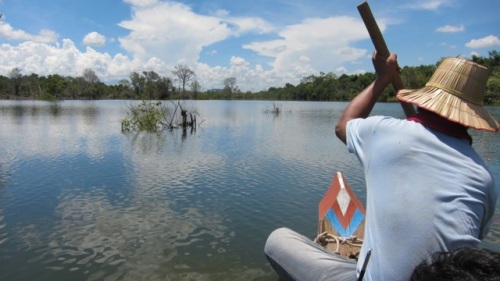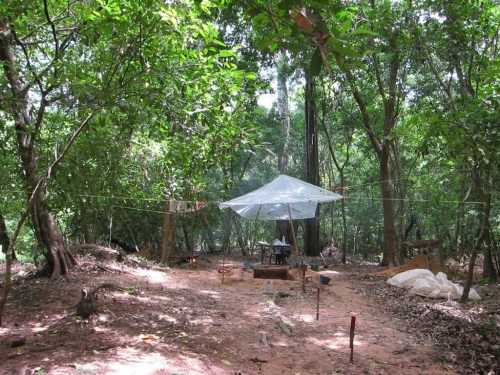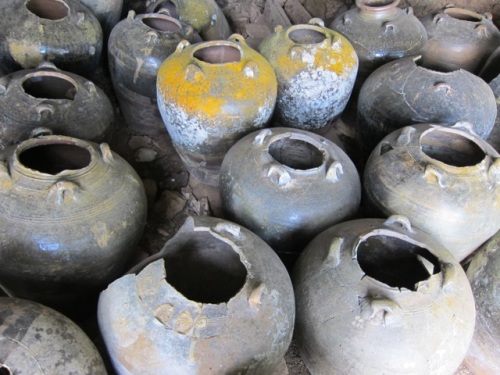Curmudgeon month continues here as I take another myth about Angkor to task. This time it’s the silly “Stegosaurus at Ta Prohm” rumor. This myth has been popularized by young earth creationists*, who’ve argued that one particular small carving on a doorway at Ta Prohm depicts a Stegosaurus. Never mind that the entire temple is covered with carvings of fantastic and mythical creatures, this one carving is evidence that humans and dinosaurs co-existed.

Carving on Ta Prohm. This is not a stegosaurus.
Continue reading →
I suppose I’m a bit of a curmudgeon and therefore get fairly easily annoyed. One of my biggest pet peeves is the old myth about how the French, specifically the explorer and researcher Henri Mouhot, “discovered Angkor” in 1860. This myth is based on an idea that the Cambodians had no knowledge of their past, and therefore helped the French justify their colonial rule in “restoring a nation to its past grandeur” (Dagens 1995:47). As Angkor has been in the news lately, due to the recent BBC documentary, this factual inaccuracy continues to be perpetuated. It’s time for this myth to die.

A drawing of Angkor Wat by Henri Mouhot, who did not discover Angkor.
Continue reading →
Last year I had the opportunity to do a small excavation at the site of Chau Srei Vibol. Although the excavation wasn’t very productive, I enjoyed spending several days at this beautiful and quiet site that doesn’t see many tourists.

The ancient ruin of Chau Srei Vibol sits next to a modern wat.
Continue reading →
One of the major stops at the main tourist circuit at Angkor is at the South Gate entrance to Angkor Thom. However, most visitors might not realize that you can actually walk on top of the wall around Angkor Thom and get a different perspective on this ancient city.

Looking down on to the South Gate to Angkor Thom from the wall.
Continue reading →
A couple of recent articles in the Phnom Penh Post gave some interesting and enlightening numbers regarding foreign tourists visiting Angkor in the past year.
In the letter, the exact number of tickets sold in 2012 was about 1.8 million. And of those, about one million visitors (59.2 per cent) bought single day passes for $20. About 700,000 visitors, or 39.8 per cent, bought three-day passes for $40, and about 18,000 visitors bought $60 weekly passes.
These numbers blew me away, 99% of the almost 2 million visitors to Angkor came for 3 or fewer days. Combine this with the fact that most tourists only come to Cambodia for a handful of days total, means that most visitors only see the major sites (Angkor Wat, the south gate to Angkor Thom, the Bayon, Ta Prohm etc.) and that most of these sites are crawling with other tourists.
The Cambodian government has been trying to encourage people to spend more time in Cambodia, but I also suspect there is a growing number of tourists (and expats) who are returning to Cambodia for a second (or third, or fourth) visit. I’ve been to Cambodia and Angkor more times than I can count, so I thought I would start sharing of my favorite “Off the Beaten Path” activities. After you’ve seen the major temples, it’s time to delve a little deeper and see more to Angkor. First up, visiting the North Baray with the Baray Reach Dak community tour.

A view from the boat on the North Baray
Continue reading →
As my previous posts have discussed, most of the press on the exciting new LiDAR data around Angkor have focused on the supposedly “lost city” on Phnom Kulen. However, the LiDAR data covered a huge area around Angkor, especially around the urban core, and what those results revealed are just as exciting. An article in this weekend’s Guardian newspaper mentions some of our fieldwork, headed by Dr. Miriam Stark. However, I was disappointed when an associated article with the headline Laser technology reveals lost city around Angkor Wat focused primarily on the work on Phnom Kulen (actually not anywhere near Angkor Wat). I’m completely biased, but I think the work we’re doing at Angkor Wat is important and exciting, so I thought it was time to discuss it a bit more here.

Above: An excavation unit in the forest around Angkor Wat
Continue reading →
13.353639
103.855655
In January of this year I was lucky enough to join the “Living in the Shadow of Angkor Project” looking at jar burials in the Cardamom Mountains. The project director, Dr. Nancy Beaven, has spent several years looking at different burial sites in the Cardamom Mountains (a list of articles about some of this previous work can be found here).

Jars at the Phnom Khnong Peung site.
There are several really cool things about this project:
- The burials date from about the 15-17th century AD, coinciding with the end of Angkor and the move of the capital further south to the region around Phnom Penh.
- The jars appear to represent an upland culture that was not Hindu or Buddhist. We know this because during the Angkorian period (and likely before) Hindus and Buddhists would cremate their dead. (Cremation is still the most common form of burial in Cambodia today). The burials in the Cardamom Mountains are different in that they were first defleshed and then their bones were collected and placed in small wooden coffins or large ceramic jars. There has been almost no archaeological research on ethnic minority communities in Southeast Asia and so these sites represent an interesting window into a little-studied way of life.
- The jars contain glass beads and metal jewelry.
Nancy and her colleagues started work at a site called Phnom Khnong Peung (ភ្នំខ្នងពើង) last year and encountered a lot of glass beads in the burial jars. When they received funding to return this year, I came a long to examine this material. More after the jump!
Continue reading →
When I was doing fieldwork in Cambodia back in February and March I was lucky enough to overlap with Dr. Martin Polkinghorne‘s excavations near the Royal Palace area in the heart of Angkor. Martin was working on the second of his two fieldwork projects excavating Angkorian stone sculpture workshops. Angkorian sculpture has been in the news a lot lately and as a result I think these objects have be come decontextualized. When viewed solely as art pieces it is easy to forget that they were made by skilled craftsmen for a specific purpose. Martin’s excavations are so exciting because his research is allowing for us to finally understand how stone sculpture fit within the broader picture of Angkorian society.

An unfinished sculpture base, with a tree growing through it, from the workshops near the Royal Palace area in Angkor Thom. Photo by Alison Carter.
Continue reading →
Perhaps one of the most photographed parts of Angkor is the south gate to Angkor Thom, where you cross a moat flanked by gods and demons depicting the Churning of the Sea of Milk.

South gate of Angkor Thom with sculptures depicting the Churning of the Sea of Milk.
If you’ve been recently, you may have noticed the APSARA Stone Conservation unit working on some of these sculptures.

APSARA Stone Conservation Unit working at the South Gate of Angkor Thom.
Also obvious is that some of the heads on the gods/demons are a different color stone than the bodies. These are new copies that have been made to replace versions now in storage at the Angkor Conservation warehouse.


A close-up of a third replica head outside the south gate of Angkor Thom.
Recently, I visited the Angkor Conservation office and I had the chance to see some of the artisans at work who are making these replica heads. The level of detail and craftsmanship involved is amazing.

Craftsman working on a replica head at the Angkor Conservation workshop.

This sculptor is working on a replica of an original head from Angkor Thom (on the right).
One baby-faced sculptor said he’d been studying stone work for 10 years (since he was 18). Also interesting was that the artisans were duplicating the “original” damage to the sculptures-not creating perfect copies.

Note the damage on the nose of both the original and copy.
Some people can be a bit snarky about the use of replica sculptures at temples in Angkor park. Perhaps there could be better signage so tourists knew when they were looking at copies vs. originals. However, the level of skill required to make accurate and beautiful copies is high, and I think these artisans deserve credit for their hard work. These artisans are part of a long line of Cambodian stone sculptors and in many ways the replicas are excellent examples of the living heritage of Angkor. When you’re visiting Angkor park, be sure to stop and admire both the ancient and modern talent involved in your temple experience.
MORE:
–Cambodian Stone Project
–Angkor Wat Replica for sale
–Martin Polkinghorne’s project investigating Angkorian stone sculpture workshops.
–Taking home a piece of Angkor is not ok.


















 BarCamp Phnom Penh
BarCamp Phnom Penh